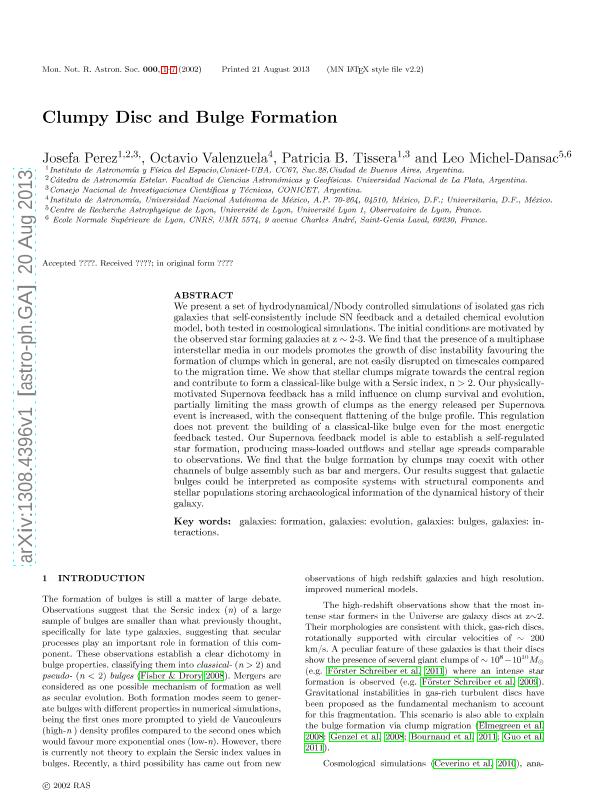Mostrar el registro sencillo del ítem
dc.contributor.author
Perez, Maria Josefa

dc.contributor.author
Valenzuela, Octavio
dc.contributor.author
Tissera, Patricia Beatriz

dc.contributor.author
Michel-Dansac, Leopold Laurent Joseph

dc.date.available
2015-06-11T19:55:57Z
dc.date.issued
2013-11
dc.identifier.citation
Perez, Maria Josefa; Valenzuela, Octavio; Tissera, Patricia Beatriz; Michel-Dansac, Leopold Laurent Joseph; Clumpy disc and bulge formation; Wiley-blackwell Publishing, Inc; Monthly Notices Of The Royal Astronomical Society; 436; 11-2013; 259-265
dc.identifier.issn
0035-8711
dc.identifier.uri
http://hdl.handle.net/11336/696
dc.description.abstract
We present a set of hydrodynamical/N-body controlled simulations of
isolated gas-rich galaxies that self-consistently include supernova (SN)
feedback and a detailed chemical evolution model, both tested in
cosmological simulations. The initial conditions are motivated by the
observed star-forming galaxies at z ? 2-3. We find that the
presence of a multiphase interstellar media in our models promotes the
growth of disc instability favouring the formation of clumps which, in
general, are not easily disrupted on time-scales compared to the
migration time. We show that stellar clumps migrate towards the central
region and contribute to form a classical-like bulge with a
Sérsic index, n > 2. Our physically motivated SN feedback has
a mild influence on clump survival and evolution, partially limiting the
mass growth of clumps as the energy released per SN event is increased,
with the consequent flattening of the bulge profile. This regulation
does not prevent the building of a classical-like bulge even for the
most energetic feedback tested. Our SN feedback model is able to
establish self-regulated star formation, producing mass-loaded outflows
and stellar age spreads comparable to observations. We find that the
bulge formation by clumps may coexist with other channels of bulge
assembly such as bars and mergers. Our results suggest that galactic
bulges could be interpreted as composite systems with structural
components and stellar populations storing archaeological information of
the dynamical history of their galaxy.
dc.format
application/pdf
dc.language.iso
eng
dc.publisher
Wiley-blackwell Publishing, Inc

dc.rights
info:eu-repo/semantics/openAccess
dc.rights.uri
https://creativecommons.org/licenses/by-nc-sa/2.5/ar/
dc.subject
Galaxies: Bulges
dc.subject
Galaxies: Evolution
dc.subject.classification
Otras Ciencias Naturales y Exactas

dc.subject.classification
Otras Ciencias Naturales y Exactas

dc.subject.classification
CIENCIAS NATURALES Y EXACTAS

dc.title
Clumpy disc and bulge formation
dc.type
info:eu-repo/semantics/article
dc.type
info:ar-repo/semantics/artículo
dc.type
info:eu-repo/semantics/publishedVersion
dc.date.updated
2016-03-30 10:35:44.97925-03
dc.journal.volume
436
dc.journal.pagination
259-265
dc.journal.pais
Reino Unido

dc.journal.ciudad
Londres
dc.description.fil
Fil: Perez, Maria Josefa. Universidad Nacional de la Plata. Facultad de Cs.astronomicas y Geofisicas; Argentina. Consejo Nacional de Investigaciones Científicas y Técnicas. Oficina de Coordinación Administrativa Ciudad Universitaria. Instituto de Astronomía y Física del Espacio(i); Argentina
dc.description.fil
Fil: Valenzuela, Octavio. Universidad Nacional Autónoma de México. Instituto de Astronomía; México
dc.description.fil
Fil: Tissera, Patricia Beatriz. Consejo Nacional de Investigaciones Científicas y Técnicas. Oficina de Coordinación Administrativa Ciudad Universitaria. Instituto de Astronomía y Física del Espacio(i); Argentina
dc.description.fil
Fil: Michel-Dansac, Leopold Laurent Joseph. Consejo Nacional de Invest.cientif.y Tecnicas. Centro Cientifico Tecnol.conicet - Cordoba. Instituto de Astronomia Teorica y Experimental; Argentina
dc.journal.title
Monthly Notices Of The Royal Astronomical Society

dc.relation.alternativeid
info:eu-repo/semantics/altIdentifier/url/http://arxiv.org/abs/1308.4396v1
Archivos asociados
